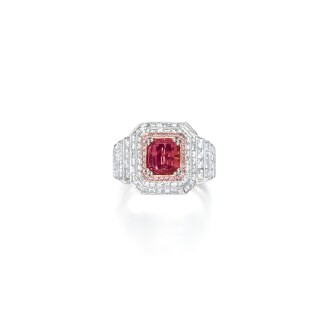Catalog Landing Page – Module Explainer
T his is a rich text module, which shows text. This is not a new feature, but continues to be the best way to show text. We'll start the catalog text off with the auction info.
This is a quote module, which is a nice way to break up blocks of text.
David Webb

J.E. Caldwell
Estimate: 225,000 – 275,000 USD
Featured Lot Module
This is a featured lot module, which must be linked to an active lot. This feature looks best if there is a paragraph or so of text to join the lot (the start of the catalog essay is likely ideal).
Hotspot Module

- This is a Hotspot Module
Place 'spots' over an image that, when clicked, offer more detail (this is a good option for showing the fine features of a piece of jewelry, work of art, etc.)d
Timeline Module
Below, find the 'double mosaic' lot feature – one lot is small, the other large
important ruby ring
The cushion-shaped ruby weighing 11.01 carats, to a mount composed of overlapping stylised leaves, size 521/2, signed G. Lenfant, Paris.
Estimate: 1,050,000 – 1,330,000 CHF
(this is an image banner, to break up the page a bit)

Here, we can have more rich text on the page, and insert some other fun things – videos, slideshows, photos, you name it.

This is a Lot List
(this is a video – the size of the video player on the page can be changed, though the possibilites are not endless).
Single Mosaic List
Estimate upon request
Throughout the history of gemstone mining, only a small handful of mines have become synonymous with a specific kind of stone. The legendary diamond mines of the Golconda region, known for exceptionally pure white diamonds; the historic and short-lived Kashmir mines, famed for their velvety sapphires; the Mogok mines of Burma, renowned for pigeon-blood rubies; and the Muzo mines of Colombia, whose output became the gold-standard for emeralds. To that list, one can add the Argyle mine of Australia, source of some of the greatest pink and, on very rare occasions, red diamonds in the world. This one mine produces over 90% of the world’s supply of those gems, and it is set to close by 2020.
Throughout the history of gemstone mining, only a small handful of mines have become synonymous with a specific kind of stone. The legendary diamond mines of the Golconda region, known for exceptionally pure white diamonds; the historic and short-lived Kashmir mines, famed for their velvety sapphires; the Mogok mines of Burma, renowned for pigeon-blood rubies; and the Muzo mines of Colombia, whose output became the gold-standard for emeralds. To that list, one can add the Argyle mine of Australia, source of some of the greatest pink and, on very rare occasions, red diamonds in the world. This one mine produces over 90% of the world’s supply of those gems, and it is set to close by 2020.














